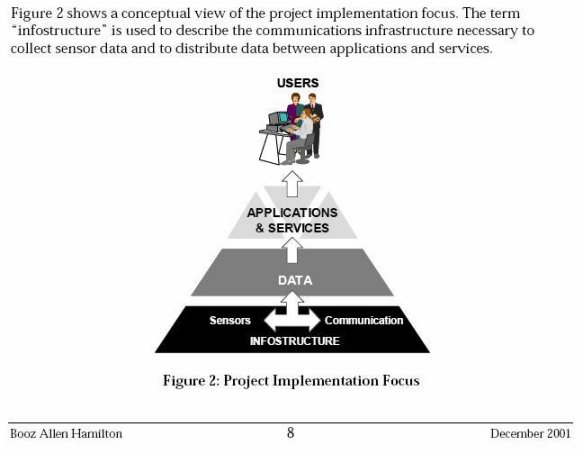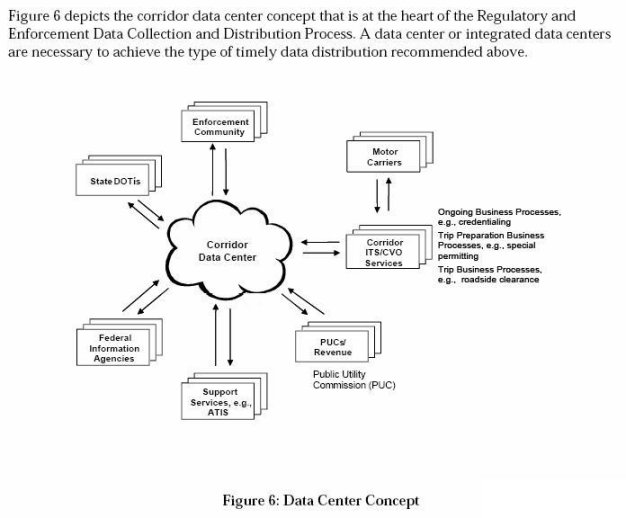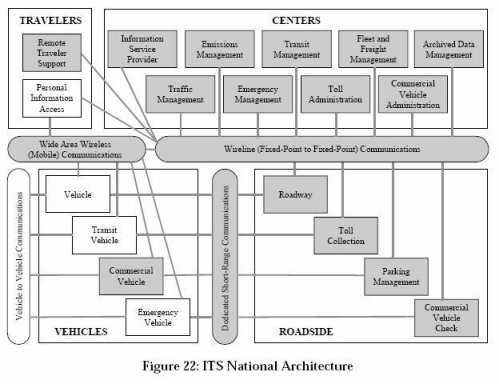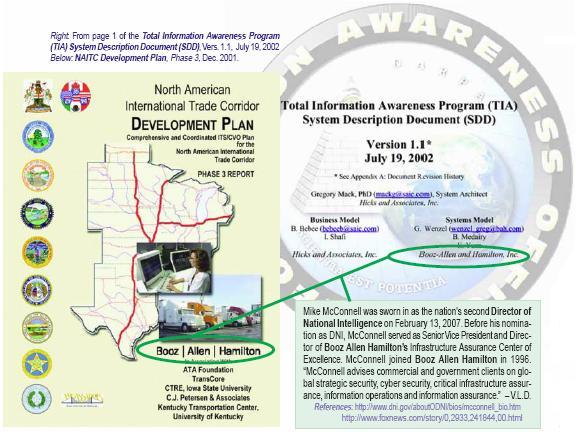The IT Project That Ate
America
Page 3
Technology - Defense Contractors and Surveillance
In a report to Congress titled, "Non-Technical Constraints and Barriers to Implementation of Intelligent Vehicle-Highway Systems", it said the following regarding use of Defense Contractors for the IVHS industry:
It is estimated that IVHS-related employment will rise from 21,000 in 1996 to 219,000 in 20 11. By 20 11, employment in the IVHS sector will account for a substantial share of the work force for certain highly skilled occupations. There should, however, be no major difficulty in meeting that demand. The Nation’s declining defense sector could be an important source of scientific, professional, and technical expertise for the IVHS industry. However, IVHS products and services will be deployed, operated, and maintained under conditions that are quite different from traditional defense sector practices, such as building relatively few high-technology products for a single client.1
That last statement was a promise they couldn't - and it is the feeling of this writer, that they never intended to fulfill.
Defense Technology Conversion - Report to Congress2
"The United States is the world leader in many technologies applicable to IVHS, and numerous efforts are currently underway to assess the feasibility of converting existing aerospace and defense technologies to IVHS. For example, DOT and the Department of Energy (DOE) entered into a Memorandum of Understanding on August 6, 1993, that will promote the use of the defense technology expertise of DOE’s national laboratories in DOT’s IVHS program.
Discussions have also taken place between DOT and various elements of the Department of Defense (DOD) and the Advanced Research Projects Agency (ARPA) to convert applicable defense technologies to IVHS. Potentially applicable technologies include: high-definition imaging and displays, advanced sensors (e.g., infrared, microwave, acoustic), radar/lidar technologies, simulation modeling, telecommunications, advanced software (e.g., systems control, image processing, and data infusion), artificial intelligence technologies, and vehicle robotics and location systems.
The GPS system. with its network of satellites, IS already a component of many IVHS systems. DOT has been identified to work closely with DOD to facilitate the proper implementation of GPS for civilian use, and to ensure the long-term availability of GPS as a U.S. national asset that would be available to civilian users worldwide.
The defense industry already recognizes the potential of the IVHS program, and some 50 defense organizations are members of IVHS AMERICA, including ARPA, the U.S. Tank and Automotive Command (TACOM), Martin Marietta, and Hughes Aircraft, In addition, over 20 defense community contractors are participating in the AI-IS Precursor Systems Analyses studies and ten defense contractors are involved in the development of the national IVHS system architecture. Continued utilization of the resources represented by the defense and aerospace industry will be instrumental in advancing the national IVHS program and bringing IVHS systems to deployment."
Spy Satellites for Civilian Use 4
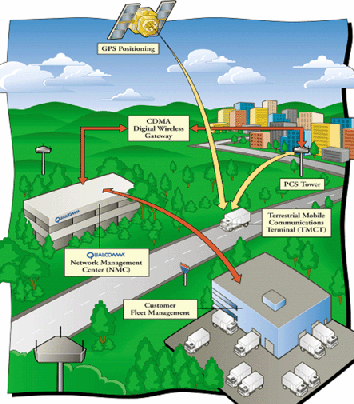
Commercial Remote Sensing and National Security3
Dennis Jones
In February 2002, Colombian President Andres Pastrana appeared on his nation's television and declared an end to peace negotiations with the Revolutionary Armed Forces of Colombia, an insurgent group that the government had been fighting for decades. In supporting his decision, Pastrana held up satellite photographs of clandestine road networks developed in the demilitarized zone in the south of Colombia—a violation, he argued, of the two-year-old peace process. The photos he held up for his nation and the world to witness were not declassified images from a Colombian military satellite, nor were they from any U.S. defense system. They were purchased from a U.S. commercial satellite company.
Pastrana's display of commercial satellite imagery received little notice in the media, which was naturally more concerned with his policy announcements. It was, however, one of the most dramatic manifestations of a policy signed by President Clinton in 1994, Presidential Decision Directive-23, U.S. Policy on Foreign Access to U.S. Remote Sensing Capabilities. Aerospace had a role in implementing that policy and later helped shape the directive that would succeed it.
A Landmark Directive
Presidential Decision Directive-23 (or PDD-23, as it is commonly known) had its roots in the Land Remote Sensing Policy Act of 1992, which established the terms for civil and commercial remote sensing in the U.S. Government. The act designated the National Oceanic and Atmospheric Administration (NOAA) as the chief regulatory agency for the commercial remote-sensing industry and outlined the general terms and conditions required to obtain a license to operate a remote-sensing satellite in the United States. These included, for example, the submission of on-orbit technical characteristics of the proposed system for NOAA review. The act also stipulated that a licensee "operate the system in such a manner as to preserve the national security of the United States and to observe the international obligations of the United States." These conditions required the government to investigate the ambiguous nexus between technology development and national security and decide on the best course of action. Accordingly, Aerospace began conducting research and analysis to assist the investigation and decision-making process.
* * * * *
Presidential Decision Directive-23: Land Remote Sensing Policy Act of 19925
xxxxxxxxxxxxxxxxxxxxxxxxxxxxxxxxxxxxxxxxxxxxxxxxxxxxxxxxxxxx
Booz Allen
Hamilton
North American International Trade Corridor (NAITC)
Development Plan - Phase 37
In the above picture, focus on "Personal Information Access" because that's where "Total Information Awareness" comes in. Defense contractors design systems to foil the enemy, the collection of every scrap of data about "the enemy" makes sense in the defense arena but not for a civilian population of non-combatants engaged in the ordinary business of living.
The graphic below is from a publication titled, "NAFTA Superhighway Memory Hole"8 which traces the history of the usage of the name "NAFTA Superhighway". The report was produced to stop the disinformation campaign that attempted to deny the existence of the "NAFTA Superhighway" on the basis of semantics. In researching the history, the link was made between the 'Intelligent Vehicle Highway System (IVHS)' as Total Domain Awareness as a component of 'Total Information Awareness'. Upon reflection, it should have been reversed. Total Information Awareness is a component of Total Domain Awareness but that's an arcane distinction without a real difference.
Al Gore and the Internet
When Al Gore said that he created the Internet and everybody laughed, it was a misstatement only in the use of the word "created"9. Al Gore did in fact, enable the Internet to be built with the capacity for government, industry and educational use when, as Senator Al Gore, he introduced and successfully ushered through the legislative process, the "High Performance Computing Act of 1991"10.
The following are excerpts from Senator Al Gore's floor speech11 when the bill was introduced:
By Mr. GORE (for himself, Mr. Jeffords, and Mr. Durenberger):
S. 1067. A bill to provide for a coordinated Federal research program to ensure continued United States leadership in high-performance computing: to the Committee on Commerce, Science, and Transportation.
NATIONAL HIGH-PERFORMANCE COMPUTER TECHNOLOGY ACT
Mr. GORE. Mr.President, I am today introducing the National High-Performance Computer Technology Act
of 1989 to respond to major economic and technological challenge- the battle to ensure the United States'
leadership in advanced computing and computer networking.
High-performance computing is the most powerful tool available to those who, in an increasing number of
fields, are operating at the frontiers of imagination and intellect. The nation which most completely
assimilates high-performance computing into its economy will very likely emerge as the dominant
intellectual, economic, and technological force in the next century.
Three years ago, on the 30th anniversary of the Interstate Highway System, I sponsored the Supercomputer
Network Study Act to explore a fiber optic network to link the Nation's supercomputer into one system.
High-capacity fiber optic networks will be the information superhighways of tomorrow. A national network
with associated supercomputers and data bases will link academic researchers and industry in a national
collaboratory. This information infrastructure will cluster research centers and businesses around network
interchanges, using the Nation's vast data banks as the building blocks for increasing industrial productivity,
creating new products, and improving access to the same national resources-data bases, supercomputers,
accelerators-as more affluent and better known institutions.Can we rely on the market system to provide this kind of infrastructure? We certainly couldn't where the
Interstate Highway System was concerned, although private industry ultimately benefited a great deal from
the Government's leadership and investment. I believe that the Federal Government must again be a
catalyst, to get companies interested in those information networks and show them that there is a market
out there. Clearly, the technological spinoffs and productivity gains would be enormous, from a network that
would cost the Government less than one Stealth bomber.
Referring back to Title VI of the ISTEA legislation of 199112 pertaining to the Intelligent Vehicle Highway System, the language pertaining to the funding for five university research institutes, 'technology transfer', a new applied research facility, etc. to develop the equipment and software that would work under "real world" conditions, it becomes pretty clear that the universities were actually used to develop the hardware and software that would eventually be sold back to 'We The People' through our state and local governments. Furthermore, this goes far to explain why imported foreign students have taken over the graduate programs in the universities. They not only pay more for tuition (supposedly), they are also a source of incredibly cheap labor for high value technology research and development for products paid for by U.S. taxpayers - the profits from which benefit insiders to deals as they are sold back to the U.S. taxpayers. If this isn't racketeering (RICO), it should be.
Excerpt from the TEA-21 legislation (passed 1998) brochure:13
"With the passage of TEA-21, the ITS program has fundamentally shifted from a program of research and development to one primarily focused on infrastructure deployment. More importantly, the direction from Congress is clear: technology will underpin the surface transportation system of tomorrow — and today. ITS has arrived!" Christine M. Johnson, Ph.D, Director, ITS Joint Program Office
Sweet Deals for Insiders - get paid by the government to develop the product or software - and then you own it and can sell it.
1992 Strategic Plan for the Intelligent Highway System14
Intellectual Property Rights
Many cooperative arrangements among government, the private sector, and universities are envisioned as part of the development process of IVHS. They include research consortia and operational test joint ventures. It is important that understandings and agreements regarding rights to intellectual property be reached at the beginning of each project.
The federal government now has fairly broad latitude regarding the intellectual property rights it may grant to recipients of federal funds. Such arrangements may go as far as, but do not always extend to, granting to the non-federal party rights to inventions developed in performance of an agreement, as long as the federal government retains a nonexclusive, nontransferable, irrevocable, paid-up license to use the subject invention.
The policy for copyrighted material (which includes computer software) is similar. The non-federal party generally may copyright the material developed under the funding agreement, as long as the federal agency reserves a royalty-free, nonexclusive, and irrevocable license to reproduce, publish, or otherwise use, as well as to authorize others to use the copyrighted material for federal government purposes.
When federal funding is to be used as part of a cooperative project, federal requirements should be formulated and stated early in the discussions or at the earliest possible stage of pre-procurement activity if a formal procurement is required. Arrangements for separating federal and non-federal funding in the project may be appropriate in order to safeguard proprietary concerns.
To Be Continued
I'm sending this out before it's finished because of some very important issues on the national level that are related to what I've written. First, the license to spy on American citizens permanently that Bush is asking for in pending legislation. I believe - but do not know for certain that this legislation is related to INTERNET 2 - which I also think is related to the conversion to HD-TV. The retroactive immunity is probably because of the testing that was required before the system goes live - which is in 2009 I believe. I've only scratched the surface of this issue but I have two documents that I believe are clues to what the real issues are:
In this newsletter, there is a very interesting debate about the U.S. government under Clinton funding the building of a 2nd Internet backbone - Internet 2.
Debate Funding of Internet 2 see page 8 (adobe), Thomas Tauke
Agenda on Internet 2 - Government website - description of Internet 2. I had already decided to cancel my cable subscription once the HD TV system is switched on permanently because my suspicions were that this technology gives the government and their "partners" the ability to see me in my own home - in other words - 2 way viewing and communications. From the description I read on the link above, I was right. So what that means is that before the switch can be flipped on HDTV - Internet 2, the legislation to allow spying on American citizens without a warrant has to be passed because by definition, this technology is a permanent spy in your home that can be tapped into.
Second, public meetings will be held soon to discuss the 'taking' of a huge swatch of property through several national parks using the utility right of way laws. Obviously the amount of land they want to take isn't for utilities, it's for the CANAMEX highway - they just aren't saying it that way.
Energy corridors proposed across public lands in West
BY MATTHEW BROWN - THE ASSOCIATED PRESS
Edition Date: 11/17/07
Utility Corridor Maps
http://corridoreis.anl.gov/eis/dmap/index.cfm
1) Department
of Transportation, Report to Congress, "Nontechnical
Constraints and Barriers to Implementation of Intelligent
Vehicle-Highway Systems, June 1994, Page viii (11)
http://www.its.dot.gov/JPODOCS/REPTS_TE/61X01!.PDF
2) Intelligent
Vehicle Highway Systems Program Plan (IVHS), Report to
Congress, June 1994, page 24 (29)
http://www.itsdocs.fhwa.dot.gov/JPODOCS/REPTS_PR/740.pdf
3) The Aerospace Corporation article, "Commercial Remote
Sensing and National Security", Dennis Jones, Summer 2004, http://www.aero.org/publications/crosslink/summer2004/09.html
4) Federal Motor Carrier Safety Administration,
Technologies,
http://www.fmcsa.dot.gov/facts-research/research-technology/report/untethered-dec05/section2.htm?printer=true
5) Federation of American Scientists, Office of the White
House Press Secretary, Fact Sheet - Foreign Access To Remote
Sensing Space Capabilities, Release Date: March 10, 1994.
http://www.fas.org/irp/offdocs/pdd23-2.htm
6) GPRS World Tracker, "Track anyone, anywhere, anytime",
http://www.trackingtheworld.com/
7) Booze Allen Hamilton, North American International Trade
Corridor, Development Plan, Phase 3, December 2001, Page 8 (pdf
p.16), Page 66 (pdf p.74) Page 116 (pdf p.124)
http://www.channelingreality.com/Documents/NAITC_ITS-CVO_PlanPhase-3-Final.pdf
8) NAFTA Superhighway Memory Hole, D. Niwa, September 12,
2007, Page 6
http://www.channelingreality.com/Documents/NAFTA_Superhighway_07.pdf
9) Wikipedia, High Performance Computing and Communication
Act of 1991, ref date: January 27, 2008
http://en.wikipedia.org/wiki/High_Performance_Computing_and_Communication_Act_of_1991#_note-0
10) National Coordination Office for Networking and
Information Technology Research and Development,
Congressional Laws, "High Performance Computing Act of
1991", Public Law 102-194.
http://www.nitrd.gov/congressional/laws/pl_102-194.html
11) Electronic Frontier Foundation, Senator Al Gore, Senate
Floor Speech introducing, 'National High-Performance
Computer Technology Act' aka Gore Bill (S.1067).
http://w2.eff.org/Infrastructure/Old/s1067_89_gore_hpc.bill
12) National Transportation Library, Summary Intermodal
Surface Transportation Efficiency Act of 1991,
http://ntl.bts.gov/DOCS/ste.html Excerpt Title VI
C:\Inetpub\wwwroot\Channelingreality\NAU\title_vi__istea_of_1991.htm
13) Department of Transportation, Federal Highway
Administration, Intelligent Systems in the Transportation
Equity Act for the 21st Century, TEA-21, Publication
FHWA-JPO-99-040, 1-11-98
14) Strategic Plan for Intelligent Vehicle Highway Systems in
the United States, IVHS America, Report No: IVHS-AMER-92-3,
May 20, 1992, Intellectual Property, Page III-130-131 (pdf p.199-200)
http://www.itsdocs.fhwa.dot.gov/JPODOCS/REPTS_PR/1823.pdf
(large)
Vicky Davis,
January 28, 2008
Vicky L. Davis was a Computer Systems Analyst/Programmer who spent 20 years designing and writing computer systems for large corporations and state and local governments. For 15 of those years, she worked as a Contractor, which gave her exposure to a wide variety of different businesses and their internal applications and operations. She has traveled extensively and has lived in nine states in the course of her life’s adventure
